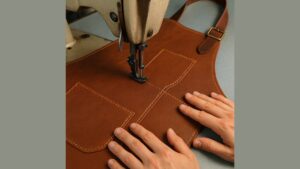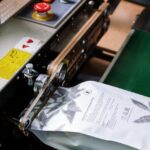Saddle stitching is one of the most reliable methods for hand-sewing leather. Unlike machine stitches that can unravel when broken, saddle stitching locks each stitch in place, making it ideal for leather items that need extra durability. This technique is widely used for crafting leather jackets and aprons, ensuring they last longer and maintain strength even with frequent use.
Leather aprons come in different styles, each designed for a specific purpose. Some are used in kitchens, while craftsmen and tradesmen prefer others. A tough leather carpenter’s apron needs to be tough enough to handle constant movement, sharp tools, and heavy wear. Saddle stitching helps reinforce its seams, preventing premature wear and tear, which is why it’s a go-to choice for high-quality leatherwork in the USA.
Why Saddle Stitching is Best for Leather Jackets & Aprons
Saddle stitching is known for its strength and durability, making it the perfect choice for both leather jackets and aprons. Unlike machine stitching, which relies on a single thread looped through the material, saddle stitching uses two needles and a continuous thread, creating a secure and long-lasting seam.
For leather jackets, this technique adds flexibility while preventing stitches from coming loose over time. This is especially useful for jackets that need to withstand bending and stretching. On the other hand, leather aprons, particularly those used in woodworking or metalworking, face heavy-duty use. A well-stitched seam ensures they can handle daily wear without fraying or splitting.
Step by Step Guide to Saddle Stitch Leather Jackets and Aprons
Before you start, having the right tools is crucial for achieving clean and even stitches. Investing in high-quality leather stitching tools will make the process easier and ensure a polished look. Here are the main leather stitching that you will need:
- Pricking iron
- Stitching awl
- Stitching pony
- Waxed linen thread
- Two blunt stitching needles
- Leather clamp or stitching pony
- Ruler and wing divider
- Lighter or thread zapper
Before starting the stitching process, it’s important to prepare the leather properly to ensure strong, even, and long-lasting seams. Follow these steps to saddle stitch your leather jackets or apron with precision and durability:
Mark and Punch Stitching Holes
Before stitching, marking and punching holes ensures that the stitches are straight and evenly spaced. Start by drawing a stitching line using a wing divider or ruler to guide the placement of your stitches.
Once the line is marked, place a pricking iron along it and tap it with a mallet to create evenly spaced holes. Double-check the alignment before stitching to avoid misaligned seams. Taking the time to pre-punch the holes will make stitching smoother and improve the durability of the finished product.
Prepare the Waxed Linen Thread and Needles
Choosing the right thread is crucial for strong and long-lasting stitches. Cut a piece of waxed linen thread that is about four times the length of the stitching line to ensure you have enough for the entire seam. Attach a needle to each end of the thread, making sure it is centered to balance both sides. If your thread isn’t pre-waxed, run it through beeswax to improve durability and reduce friction while stitching.
Start Saddle Stitching
Saddle stitching is a method that creates a strong, reliable seam using two needles. Begin by inserting the first needle through the first hole and pulling it until both ends of the thread are equal. Next, insert the second needle through the same hole from the opposite side and pull both threads snugly.
Repeat this process for each hole, making sure to maintain even tension as you go. This stitching technique is ideal for leather jackets and practical leather aprons, as it provides durability and flexibility. Keeping the right tension ensures that the stitches hold well and look neat. Pulling too tightly can cause the leather to wrinkle or distort, especially on jackets where flexibility is needed.

Secure the Final Stitch
Ending the stitching properly prevents the thread from loosening over time. Once you reach the last hole, backstitch through the previous two holes to lock the thread in place. Trim any excess thread close to the leather surface without cutting too close to the knot. For additional security, lightly melt the thread tips with a lighter or thread zapper to prevent fraying.
Burnish and Finish the Leather
After stitching, burnishing and finishing, add the final touches for durability and a polished look. Use a wooden slicker or canvas cloth to rub the leather edges, smoothing them out and enhancing the seam’s strength. Applying an edge finish, such as leather dye or edge coat, further protects the leather and improves its appearance. Inspect your work to ensure all stitches are tight and secure, giving your leather project a well-crafted, professional look.
Common Mistakes to Avoid When Saddle Stitching
Even skilled leatherworkers make mistakes when saddle stitching. Here are some common ones to watch out for:
Uneven Stitch Spacing
When stitching leather, keeping the stitches evenly spaced is essential for both strength and appearance. If the spacing is inconsistent, some areas may have weak spots that are more likely to tear over time. Uneven stitches can also make the seam look messy, taking away from the professional finish of your leather jacket or apron.
Incorrect Thread Tension
The way you pull the thread through the leather plays a big role in how the final stitch looks and functions. If the thread is pulled too tightly, it can cause puckering, making the leather wrinkle and distort the shape of the jacket or apron. On the other hand, if the tension is too loose, the stitches won’t hold properly, causing the seam to weaken over time.
Skipping Pre-Punching Holes
One of the biggest mistakes in saddle stitching is sewing without pre-punching holes. Leather is thick and tough, and trying to push a needle through without prepared holes can lead to crooked or misaligned stitches. This not only makes the project look untidy but can also damage the leather. Using leather stitching tools such as an awl or pricking iron helps create evenly spaced holes, which facilitates a smooth seam.
Conclusion
Saddle Stitch Leather Jackets is the best method for hand-sewing leather jackets and aprons, providing a secure, long-lasting seam. By following these steps and avoiding common mistakes, you can achieve professional-quality results. Whether you’re reinforcing a carpenter leather apron of crafting a stylish leather jacket, mastering this technique ensures durability and strength in every stitch.







